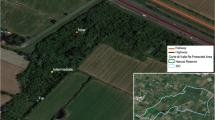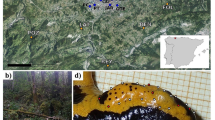Abstract
Anthropogenic noise may mask effective vocal signal transmission by birds, particularly in notes occurring in lower frequencies. Previous studies have shown a correlation of increased urban noise levels, higher minimum frequency, and lowered bandwidth in Great Tit song (Parus major). We therefore studied the effect of urban noise pollution on the song characteristics of the closely related Eastern Great Tit (EGTs, Parus minor) at Hongneung experimental forests (HEFs) in the metropolitan urban of Seoul, Korea. We analysed the song characteristics of breeding territories of EGTS in total 13 individuals recorded including four individuals at high noise group. EGTs singing in noisier locations exhibited higher minimum & maximum frequency, and lower note & strophe length, and higher bandwidth, replicating the different findings of Great Tits. This data also suggests that several individuals at high noise location exhibited a non-typical song type indicative of structural adaptation to higher noise levels. Although the mechanisms of these correlations are as yet undetermined, it is likely that behavioural plasticity may play a role of vocal signal adaption in an increasingly urbanizing Korea.





Similar content being viewed by others
References
Bermúdez-Cuamatzin E, Ríos-Chelén AA, Gil D, Garcia CM (2009) Strategies of song adaptation to urban noise in the house finch: syllable pitch plasticity or differential syllable use? Behaviour 146:1269–1286
Bioacoustics Research Program (2012) Raven pro: interactive sound analysis software (Version 1.5). The Cornell Lab of Ornithology, Ithaca
Brumm H (2004) The impact of environmental noise on song amplitude in a territorial bird. J Anim Ecol 73:434–440
Brumm H, Slabbekoorn H (2005) Acoustic communication in noise. Adv Study Behav 35:151–209
Brumm H, Slater PJB (2006) Ambient noise, motor fatigue, and serial redundancy in chaffinch song. Behav Ecol Sociobiol 60:475–481
Dhondt AA, Lambrechts MM (1991) The many meanings of great tit song. Belg J Zool 121:247–256
Dingle C, Halfwerk W, Slabbekoorn H (2008) Habitat-dependent song divergence at subspecies level in the grey-breasted wood-wren. J Evol Biol 21:1079–1089
Eck S, Martens J. (2006) Systematic notes on Asian birds. 49. A preliminary review of the Aegithalidae, Remizidae and Paridae. Zool Med Leiden 80–5(1). Germany
Fernández-Juricic E, Poston R, de Collibus K, Morgan T, Bastain B, Martin C, Jones K, Treminio R (2005) Microhabitat selection and singing behavior patterns of male house finches (Carpodacus mexicanus) in urban parks in a heavily urbanized landscape in the Western U.S. Urban Habitats 3(1):49–69
Franco P, Slabbekoorn H (2009) Repertoire size and composition in great tits: a flexibility test using playbacks. Anim Behav 77(1):261–269
Halfwerk W, Slabbekoorn H (2009) A behavioural mechanism explaining noise-dependent frequency use in urban birdsong. Anim Behav 78(6):1301–1307
Krebs JR (1977) The significance of song repertoires: the beau Geste hypothesis. Anim Behav 25:475–478
Lambrechts MM (1997) Song frequency plasticity and composition of phrase versions in great tits Parus major. Ardea 85:99–109
Lambrechts MM, Dhondt AA (1986) Male quality, reproduction, and survival in the great tit (Parus major). Behav Ecol Sociobiol 19(1):57–63
Lambrechts MM, Dhondt AA (1987) Differences in singing performance between male great tits. Ardea 75:43–52
Lengagne T, Aubin T, Lauga J, Jouventin P (1999) How do king penguins (Aptenodytes patagonicus) apply the mathematical theory of information to communicate in windy conditions? Proc R Soc Lond B 266:1623–1628
Lohr B, Wright TF, Dooling RJ (2003) Detection and discrimination of natural calls in masking noise by birds: estimating the active space of a signal. Anim Behav 65:763–777
Lombard E (1911) Le signe de l’elevation de la voix. Ann. Maladies Oreille, Larynx, Nez, Pharynx 37:101–119
McGregor PK, Krebs JR (1989) Song learning in adult great tits (Parus major): effects of neighbours. Behaviour 108:139–159
Mockford EJ, Marshall RC (2009) Effects of urban noise on song and response behaviour in great tits. Proc R Soc Lond B 276:2979–2985
Morton ES (1975) Ecological sources of selection on avian sounds. Am Nat 109:17–34
Nemeth E, Brumm H (2009) Blackbirds sing higher-pitched songs in cities: adaptation to habitat acoustics or side-effect of urbanization? Anim Behav 78(3):637–641
Patricelli GL, Blickley JL (2006) Avian communication in urban noise: causes and consequences of vocal adjustment. Auk 123:639–649
R Core Team. (2016) R: a language and environment for statistical computing. R Foundation for Statistical Computing, Vienna. https://www.R-project.org/
Salaberria C, Gil D (2010) Increase in song frequency in response to urban noise in the great tit (Parus major) as shown by data from the Madrid (Spain) city noise map. Ardeola 57:3–11
Searcy WA, Andersson M (1986) Sexual selection and the evolution of song. Annu Rev Ecol Syst 17:507–533
Shapiro SS, Wilks MB (1965) An analysis of variance test for normality. Biometrika 52:591–611
Slabbekoorn H, Peet M (2003) Birds sing at a higher pitch in urban noise. Nature 424:267
Slabbekoorn H (2004) Singing in the wild: the ecology of birdsong. In: Marler P, Slabbekoorn H (eds) Nature's music the science of Birdsong. Elsevier Academic Press, Amsterdam, pp 178–205
Slabbekoorn H, den Boer-Visser A (2006) Cities change the songs of birds. Curr Biol 16:2326–2331
Slabbekoorn H, Smith TB (2002) Habitat-dependent song divergence in the little greenbul: an analysis of environmental selection pressures on acoustic signals. Evolution 56:1849–1858
Sorjonen J (1986) Song structure and singing strategies in the genus Luscinia in different habitats and geographical areas. Behaviour 98:274–285
Warren PS, Katti M, Ermann M (2006) Urban bioacoustics: it's not just noise. Anim Behav 71:491–502
Wiley RH (1991) Associations of song properties with habitats for territorial oscine birds of eastern North America. Am Nat 138:973–993
Wood WE, Yezerinac SM (2006) Song sparrow (Melospiza melodia) song varies with urban noise. Auk 123:650–659
Author information
Authors and Affiliations
Corresponding author
Rights and permissions
About this article
Cite this article
Lee, C., Park, C.R. An increase in song pitch of eastern great tits (Parus minor) in response to urban noise at Seoul, Korea. Urban Ecosyst 22, 227–233 (2019). https://doi.org/10.1007/s11252-018-0809-z
Published:
Issue Date:
DOI: https://doi.org/10.1007/s11252-018-0809-z




